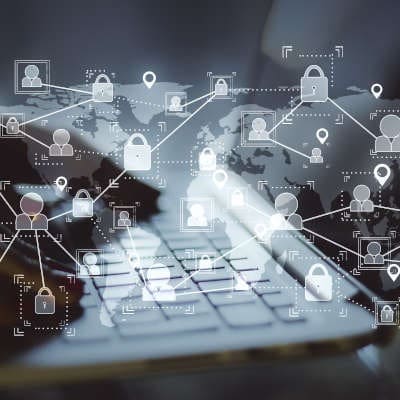These are all reasonable requests. However, as a business owner you also need to maximize productivity, bring in revenue and try to grow your business in these demanding times. How can you accomplish these goals when your office is now a ghost town and productivity has fallen off a cliff? The answer lies in setting up your office to function remotely. If you’ve never implemented a work-from-home policy before, it may seem like a whole different world. Managing an entirely remote workforce goes far beyond giving your employees a laptop and reminding them to check in every once in a while. After all, there are many factors most business owners haven’t ever had to consider, such as: What technologies do I need? How can my employees work from home without compromising the security of our network? How can I make this new work environment as easy, comfortable and productive as possible? We understand these are unique times. We know that “business as usual” is going to be quite different for an undetermined amount of time. But together we can help you adjust to today’s new normal by giving you the tools, technologies and insights to create a secure and productive work-from-home business environment. Here are three important considerations to getting you set up and running a successful work-from-home business: 1. Don’t allow employees to use home computers or devices. Their mindset may be, “Well, I’m working from home so I may as well use my home computer.” This is a dangerous mistake. Our team works hard to ensure your company computers and network are secure and protected from malware, viruses and cyber-attacks. Their home computers and devices could be littered with tons of downloaded music, videos, images and more. Because it’s more exposed, it can invite malware into your network. Rather, provide a company-approved and secured computer/laptop for employees to use at home. 2. Secure their WiFi access point. Without a secure WiFi access point, you’re essentially leaving a back door open to hackers. That’s because WiFi signals are often broadcast far beyond your employees’ homes and out into streets. Yes, drive-by hacking is popular among cybercriminals today. A few tips for securing your employees’ WiFi access points: Use stronger encryption and a more complex password Hide your network name Use a firewall These security measures are not difficult to set up. But if you have any questions or need assistance, we will be happy to help get your employees set up remotely. 3. Use a two-factor authentication VPN. VPN stands for virtual private network. It’s essentially a private, encrypted tunnel that goes direct to your IT network in your office. Ideally, you’ll want your VPN to support two-factor authentication. This means it’s doubly secure because your employees will need to call in to access the network. If you don’t have a VPN for your employees to use, you can consider other services, such as GoToMyPC or Zoho. While these products are not as secure, at least they keep your home network from being exposed. As business owners ourselves, we too are having to pivot and work differently than we ever have before. However, because we have the technology and infrastructure in place, we are still surprisingly productive. Our team wants to help your business survive and thrive during today’s […]
Communication Is (and Isn’t) Easy If a business is in operation today, it’s a safe bet that their employees each have their own email account for the business. Email usually serves as a good foundation for a business’ communication strategy, as it is a convenient means of communicating internally, with any vendors you are working with, or with your clients. However, email isn’t perfect. There is the chance that miscommunications can occur when using email—and on a related note, instant messaging—and ultimately derail your productivity. To help prevent this situation, it is recommended that more complicated communications take place using video conferencing. Combining webcams and microphones, video conferencing allows people to interact with each other in a format that provides non-verbal cues that written correspondence and telephony just don’t express. With the right solution, meetings and discussions can be held between parties in different postal codes practically as if they were in the same room. Therefore, it can be considered best practice to have a comprehensive assortment of collaboration tools at your disposal for use in different circumstances. Etiquette Matters When communicating within a team, it is important that a certain level of decorum is maintained. For example, important conversations are not the place for redundancy. If a conversation drags on for too long or has far too many irrelevant details that drown out the important ones, the people who are supposed to get the message are far more likely to miss it. Make sure your team is subscribing to the KISS principle as much as they can when they are sharing important information with one another. Sarcasm also doesn’t translate well in many methods of communication, so avoiding its use is best, especially when remote work is involved. If someone misses the joke, it could create serious issues in your company culture and/or your productivity. On a related note, insist that your team keep important conversations free of jokes, memes, and emojis. Even if Grumpy Cat had some amusing commentary to offer that summed up the gist of your conversation well, there is the risk that the testy tabby will distract from an important detail. Make sure that any messages you share with your team are also very easy to understand, and if you receive some that aren’t, don’t be shy about asking for clarification. For collaboration to work properly, the right information needs to be passed along efficiently and comprehensively. This also makes proofreading especially important. Spending a few extra seconds to go over what you’ve written to make sure that there aren’t mistakes, omissions, or other factors to get in the way of what you’re trying to say helps keep you from having to backtrack and explain things again later. This can also keep incorrect presumptions from influencing the results of your efforts. Remote work can be challenging to adapt to, but the right tools and behaviors to facilitate communications can simplify things considerably. For assistance in setting up the communication solutions to make remote work a feasible option for your business, reach out to SRS Networks by calling (831) 758-3636.
As a result of these unprecedented life changes in such a short amount of time, so many people today are frozen in fear. They don’t know what they can do and what they can’t do. They’re numb, fearful and questioning everything. I believe that the accomplished and determined business owners in our world are facing a unique brand of fears: Will I lose sales and revenue due to the coronavirus? What if I have to lay people off? How can I keep my team and keep them working hard? How will I continue to provide for my family? How long will this last? Here are five steps you can start taking now to stop being frozen in fear and move forward with your business, your family and living your life. Step #1: Communicate Often. You should make an effort to constantly communicate with all of your stakeholders. From your employees to your customers to your partners and vendors, stay in communication with them to share how your business is doing and how you can continue to serve them. While in-person visits may not be ideal at this time, you can always resort to the good ol’ phone, e-mail, videos or webinars. You can bet that if your customers aren’t hearing from you, they are hearing from your competitors. Step #2: Be a Valuable Resource. While money is always important, now is the time to be a trusted resource and friend to your clients and prospects. People today need bold solutions. If you’re actively bringing solutions to your clients, you become a valuable resource. If they’re simply writing a check and never hearing from you – especially in today’s environment – you’ll be first on the chopping block when they have to cut expenses. Step #3: Lean on People. It’s ironic that the one time we need people more than ever before, we are supposed to socially distance ourselves and stay in our homes. Through video conferencing and web conferencing, work together with your team, your partners and your Accountability Groups to lean on one another. Because nobody has gone through anything like this before, nobody has all the answers. But as a collective group, you will find most every answer you need. Step #4: Be MORE Than a Businessperson. They may be your employees, your colleagues and your clients. But they are PEOPLE first. And just about everyone you interact with in your business world has endless stresses when the workday is done. Their kids are home from school all day getting into who knows what. They’re worried about going to the supermarket and if there will be meat and toilet paper. They’re concerned about keeping themselves and their family healthy. When your clients and prospects start to see you not just as an IT services provider, but as a friend and someone who truly cares, that’s when they want to do business with you for life. Step #5: Be Informed But Not Obsessed. People were glued to their TVs for weeks after 9/11. As a result, although they were informed, they were also more stressed, depressed and fearful. Don’t do that to yourself. Yes, it’s prudent to know how to “flatten the curve” and protect your family, but watching too much news or social media right now can dominate […]
Improved Productivity Not trusting your staff leads to hindered progress in your business, holding back how much you can accomplish. Neither you nor your team can be as productive as possible with you overseeing every detail of their work, as your micromanagement discourages initiative and motivation. Meanwhile, your other responsibilities are left neglected. Do your best to quash any urge you have to monitor your staff so closely, and your collective productivity will increase. Increased Communications The more you trust your team, and they you, the better the transfer of information will be between you. Feedback in both directions will be more honest, as you will be able to level with your team. Likewise, they will feel free to share their insights and potential issues they have identified. Either way, overall productivity can be improved through adjustments from all involved. Inspired Team Members One of the surest signs that an employee can receive that their work is appreciated is to allow them to do their jobs unimpeded–without excessive oversight or interference from the boss–and celebrate their accomplishments after the fact. This kind of trust generates a sense of responsibility for the employee to perform, and positive reinforcement to encourage their self-startership and initiative. Why would anyone want to leave this environment? Doing this can help minimize turnover and benefit your growth. What We Have to Do with Any of This Regardless of how energized and motivated your team is, there is only so much that can be accomplished with less-than-sufficient tools. SRS Networks can provide the solutions to both assist you in building mutual trust with your team, and to help you make the most of these improvements from an operational standpoint. To learn more about how we can help, give us a call at (831) 758-3636.
You can bet there’s one group that’s not slowing down at all. In fact, they’re probably working overtime while the rest of us have our lives turned upside down. Cybercriminals and hackers know there’s no better time to strike than during a global crisis. While you are distracted and spending your time trying to make sense of this new normal, they are finding new ways into your IT network so they can steal data and passwords, compromise your clients’ private information and even demand large ransoms. Cybercrime is already on the rise and is expected to cause $6 TRILLION in damages by 2021! But, if history repeats itself, hackers will be out in full force throughout this coronavirus scare. We fully expect in the upcoming weeks that headlines will change from stories about COVID-19 to accounts of a frenzy of cyber-attacks on corporations and small businesses. Here are solutions you can implement now to help protect your business data, money and productivity: 1. Be more suspicious of incoming e-mails. Because people are scared and confused right now, it’s the perfect time for hackers to send e-mails with dangerous malware and viruses. At this moment, your in-box is probably filled with “COVID-19” subject lines and coronavirus-focused e-mails. Always carefully inspect the e-mail and make sure you know the sender. There’s a cdc-gov e-mail address out there now that’s not legitimate and is spamming in-boxes across the country. Avoid clicking links in the e-mail unless it’s clear where they go. And you should never download an attachment unless you know who sent it and what it is. Communicate these safeguards to everyone on your team, especially if they are working from home. 2. Ensure your work-from-home computers are secure. Another reason we expect a rise in cyber-attacks during this pandemic is the dramatic increase in employees working from home. Far too many employers won’t think about security as their team starts working at the kitchen table. That’s a dangerous precedent. First, make sure your employees are not using their home computers or devices when working. Second, ensure your work-at-home computers have a firewall that’s turned on. Finally, your network and data are not truly secure unless your employees utilize a VPN (virtual private network). If you need help in arranging your new work-from-home environment, we would be happy to get your entire team set up. 3. Improve your password strategy. During crises like the one we are all facing right now, your passwords could mean the difference between spending your time relearning how to grow your business and trying to recoup finances and private data that’s been hacked. Make a point now to reevaluate your passwords and direct your team to create stronger passwords. Also, while it’s so convenient to save your passwords in your web browser, it also lessens your security. Because web browsers simply require their own password or PIN to access saved passwords, a skilled hacker can bypass this hurdle. Once they access your saved passwords, they can steal as much as they want – credit card information, customers’ private data and more! Instead, you should consider a password manager to keep all of your passwords in one place. These password managers feature robust security. A few options are [LastPass, 1Password and Keeper Security Password Manager]. You, your team […]
Here are three variables you should consider when deploying a remote workforce. Employee-Owned Devices Deploying employee devices to meet your business demands is a risky proposition unless you have the right security measures in place. You will want to give your employees the technology that will give them the best chance to succeed; and, won’t cause any unnecessary problems for your data and network security. This is largely because of the way people utilize their personal PCs. On a workstation, people are told which software to use and stick to those titles, but on a person’s personal PC they have all types of software that your network administrator is unfamiliar with. This software, on a personal PC may not be updated and patched, leaving open vulnerabilities that could, very easily become major problems for your company. Since most people that work from home are using a personal device, you need a way to protect your company’s assets from the quagmire some personal PCs present. One way is to provide remote access software. This will allow users to actually remote into their workstation at work and use the resources like they would if they were sitting at their desks. The one problem with remote software is that it is often targeted by cybercriminals. You will want to ramp up network security and demand authentication procedures be enhanced when allowing computers to access business resources remotely. Insecure Connections In the same vein, when working remotely, some employees will be using shared networks. This can cause your IT administrator a lot of headaches. Most users haven’t set up network and cybersecurity resources that are as comprehensive as the ones that the business has. For this reason your employees’ networks are typically much less secure. Even the networking hardware that they use, often people’s only line of defense, is lacking as the software that runs on it isnt always updated. User Behaviors Probably most importantly here is the user. At home, on their home PC, they are much more likely to do things that they would never think of doing on their workstation in the office. Adding to that, without the constant security reminders they get at work, they are less apt to follow best practices as their workplace enters their homespace. You need to ensure that you make the point that just because they are working at home doesn’t mean that any of the practices that they’ve been drilled on can be ignored. Remind them the dangers of phishing attacks and how it is even more important to be vigilant about what they click on. The last thing we need to talk about is employee misconduct. Some employees, if given a foot, will take a mile. It is important to monitor your employee’s productivity well enough to ensure that they are doing their work, and that the work is in line with what you expect from that position. Some people won’t take to it as well as others, but by-in-large, workers that work remotely work with an ease that allows the work to be better and for productivity to not dip so much as it will cost your business. SRS Networks knows it’s a difficult time for California businesses. We’re here to help. Call us today at (831) 758-3636 to talk to one […]
Defining Ergonomics There are a lot of different ways to approach productivity, ergonomics simply being the idea that a person in a comfortable position is more prepared to be productive than one being distracted by discomfort. In the office, this is somewhat easier to accomplish, believe it or not. Most offices are equipped with furniture and equipment intended for use in the workplace, which means that they are designed to better attend to these needs than what the average employee will have at their house. These pieces of furniture are designed to encourage a user to adopt a “neutral position” in order to minimize strain and stress, due to the amount of time that is anticipated to be spent in a given seat. An acceptably “neutral” posture is challenging to maintain in other environments. The typical office desk is built much differently than the typical dining room table, or typical card table, or typical lap as the employee lounges on the couch… the big difference being the position that the employee will be in as they do so. So, how does one go about maintaining the correct posture as they spend their work time at home? Understanding the Basics First, it is important to know exactly what a “neutral” posture looks like when positioned at the workstation. The hallmarks of a neutral posture include a straight neck, relaxed shoulders, wrists unbent, and limbs either held straight or bent at a 90-degree angle. When seated, it is recommended that you maintain a position where the thighs are parallel to the floor, with your seat providing plenty of back support. Your monitor should be at eye level, or slightly below it. While this is all well and good in the office, it isn’t as though your employees are likely to have the same setup available. Working with What They Have Fortunately, with a little improvisation, it is entirely possible for your employees to make these adjustments in their own home. Let’s say their monitors are too low. Raising them with books or small boxes would be perfectly acceptable for the short term. If they are working with a laptop, send them some peripherals, like a spare keyboard and mouse, for them to use with it. Use small pillows and cushions to adjust the height and support of the kitchen chair you are seated at, and if this makes your feet dangle in the air once again, use a step stool or other object to allow them a firm foundation. Make sure that you remind your employees to take care of their work resources, including their own bodies. After all, they aren’t going to be productive if their back is too sore for them to focus. We can help make sure their technology is up to the task, whether or not they’re working remotely. To learn more about the solutions available from SRS Networks to support your newly at-home operations, give us a call at (831) 758-3636.
Problems You May See with Cloud Services Most of the cloud services companies will deploy are “as-a-Service” products designed to cut costs and provide the scalability and flexibility needed with today’s mobile workforces. As a result, there will have to be some extra diligence on the other end of this to ensure that data is secure and accessible. Loss of Service Even the biggest names in cloud computing suffer from downtime. Sure, Google, Amazon, and Microsoft’s uptime is much closer to 100 percent than they are to 99 percent, but you could still suffer from some downtime. Being sure that your staff is notified when planned outages are scheduled, it will eliminate some of the concern they have. Data Loss and Breaches Nowadays, hackers and cybercriminals are on the lookout for vulnerabilities in systems no matter who they belong to, or how they’re used. Cloud service providers typically maintain very strong security standards, and tend to use powerful tools to ward against unauthorized access to their drives. Compliance Issues Many compliance regulations require built-in transparency and sometimes that can be difficult when your organization uses cloud services. Additionally, regulations that call on proof of security may be a headache for your organization. There are resources on the market that are built to help your organization keep in compliance, but if you choose to trust SRS Networks with the management of your IT infrastructure, you will find that our IT professionals can ensure data integrity, keeping your business safe from rebuke. If you use cloud-hosted resources for your business, understanding where the holes are can keep you from having problems with platform security and data integrity. Call the IT professionals at (831) 758-3636 today to learn more about cloud security.
Use More than One Monitor The first way you can go about cutting down the need for paper copies is by expanding your display space. By utilizing a dual-monitor setup you no longer will have the need to have printed copies of information to efficiently work on your computer. Anytime you have to work with multiple documents, you can just pull them up on the screen(s). Use Application-Based Options For every business need there is an application that can help make the task a bit easier. There are applications developed to cut out the need for paper copies of anything. Cloud platforms especially provide the ability for people to collaborate right alongside each other, removing entirely the need for paper copies of projects. Note taking applications also provide a solution for people that often need to take notes. Put Print Policies in Place With the use of solutions aimed to limit the need for paper, you can then go ahead and put in strong printing policies that work to reduce the access to printers. By putting in a necessary authorization platform between your network and your printers, you can substantially limit the access to the printer or copier, reducing the need for paper and ink/toner. You can also employ certain strategies such as using both sides of a piece of paper to print on, adjusting your fonts to produce less prints, and more to reduce the amount of paper you use. Simply put, you won’t see as much cost benefit if you continue to use the same amount of ink/toner. Digitize Your Backups Not being able to find an important file is very frustrating, which is why many businesses still use physical file folders and print off hard paper copies to store in them. All those extra steps to file away documents adds up to extra expense. By digitizing your data and storing it in the cloud, you not only have access from anyplace on nearly any device, but you also have copies that won’t be lost, moved, or stolen. Your data will be where you put it, in perpetuity. If you would like to get out from under the expansive costs that printing brings onto your business, call the IT professionals at SRS Networks today at (831) 758-3636. Our technicians can start you on your way to a paperless office as soon as today.
As we are an IT company, let’s focus on two of the major corporations that we are intimately invested in–Microsoft and Google–and what steps they have taken in the face of the current global health crisis. Microsoft Microsoft’s efforts have been primarily focused on increasing awareness. Bing now offers an interactive map that tracks the virus’ spread on both a global scale and by country. Pulling from the World Health Organization, the Center for Disease Control and Prevention, the European Centre for Disease Prevention and Control, and Wikipedia, there is a lot of data to draw from. The CDC has also joined with Microsoft to build a Self-Checker tool to help evaluate a person’s need to be tested. Powered by AI, a user can establish if it would be wise to be tested, and (while it offers no concrete medical advice) suggested next steps to take. As a result, emergency services can see a reduced number of patients calling upon them, as those without a need won’t be adding pressure to the already at-maximum capacity. Google Google has also taken considerable measures to assist in awareness and education efforts. The official blog currently features a collection of posts that detail their ongoing efforts and solutions–such as educational resources for students and teachers to use, handy advice to improve video calls and other remote collaboration tools, and other small business resources. Along with these ongoing posts, Google Search has been outfitted with features to further boost awareness. Any search that references coronavirus activates an SOS Alert, generating a sidebar that delivers a situational report: what coronavirus is, its symptoms, how to prevent it, how it can be treated, and other statistics. In addition, the top stories are committed to coronavirus content, and a graph of the cases worldwide and more resources frame your results on the right side. Speaking of your results, they will be filled with tweets related to COVID-19, suggested videos to watch, and even more news updates and resources. On YouTube, there is now a curated playlist dedicated to how to better work from home, called WFH Essentials. Admittedly, these videos aren’t completely relevant to the COVID-19 guidelines, as some endorse spending time in public, but other components can be seen as useful. There have also been some changes in how YouTube creators are compensated, dinging them for unhelpful, misleading, and inaccurate information. As far as financial contributions are concerned, Google has given SMBs, healthcare organizations and their workers, and governments more than $800 million. This sum includes the support of research and the production of personal protective equipment. Interestingly, they have also set aside $340 million in Google Ad credits for small businesses to use. If you have had a Google Ad account that has been active since the beginning of 2019, check your account for a notification. While we may initially see these huge businesses as impervious to these kinds of concerns, COVID-19 has proved differently. Fortunately, many investments have been made by these businesses to fight back. How has your business coped with this crisis? Tell us in the comments, and don’t hesitate to reach out to SRS Networks to learn how the right IT solutions could potentially reduce coronavirus’ influence on your business operations.










